|
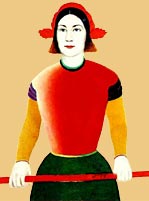 Before
investigating Constructivism and other post revolutionary
Soviet works of art and design a summary of the pre-revolutionary
avant-garde’s history must be reviewed. Before
investigating Constructivism and other post revolutionary
Soviet works of art and design a summary of the pre-revolutionary
avant-garde’s history must be reviewed.
Specialists in art when writing about this period are
unanimous in firstly assessing the situation in Russia at
the end of the 19-th, beginning of the 20-th century as a
very tense and complicated one. It is true: pre-revolutionary
situation in the country was followed by a number of bourgeois-democratic
revolutions, then the World War I and, finally, the October
Revolution of 1917. The Civil war broke out thereafter,
and changes of the post-war period brought in military communism,
devastation, hunger and fear. This period was truly very complicated
not only in Russia, and it influenced all the kinds of artistic
life - literature, music, painting, architecture, ballet,
etc.
|
 |
|
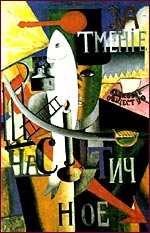 This
period in art is justifiably called The Silver Century. At
that time Russia was the country of contrasts: big cities,
industrial growth, development of all the capitalistic forms,
on the one hand, and - dark, far away villages, sleepy provinces
on the other. Chosen layers of society attained peaks in education,
culture and sciences, whereas the destiny of other society
layers was determined by illiteracy, drinking and miserable
life. All civilization stages seemed to coexist at that
time. This
period in art is justifiably called The Silver Century. At
that time Russia was the country of contrasts: big cities,
industrial growth, development of all the capitalistic forms,
on the one hand, and - dark, far away villages, sleepy provinces
on the other. Chosen layers of society attained peaks in education,
culture and sciences, whereas the destiny of other society
layers was determined by illiteracy, drinking and miserable
life. All civilization stages seemed to coexist at that
time.
This was the period during which the Russian Avant-Garde
reached its height, developing the radical new styles of Constructivism,
Futurism, and Suprematism. Although the country still faced
enormous challenges, there was a widespread sense of optimism
and opportunity.
|
|
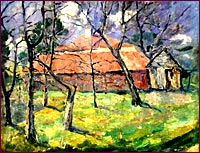 The
rising influence of European culture in Russia during the
17th and 18th centuries brought Russian artwork closer to
the familiar traditions of western painting. It wasn't until
the end of the 19th century that the next great body of uniquely
Russian artistic styles arose, having developed in conjunction
with liberal forces of social reform. The
rising influence of European culture in Russia during the
17th and 18th centuries brought Russian artwork closer to
the familiar traditions of western painting. It wasn't until
the end of the 19th century that the next great body of uniquely
Russian artistic styles arose, having developed in conjunction
with liberal forces of social reform.
From the start, the modern art movement was concerned
with breaking away from the classical tradition and creating
a new kind of art that was intimately engaged with the daily
life of Russian society. It developed a renewed interest in
traditional Russian art forms, including both decorative folk
art and, of course, icon painting. From decorative art it
gained an appreciation of the power of abstract geometrical
patterns - lines, shapes, and color were used to construct
rhythms and energetic forms, not necessarily to depict objects
or actual spaces. The re-examination of icon painting made
painters more aware of the power of a flat, two-dimensional
visual perspective. In other words, they realized that they
could treat the canvas like a canvas, rather than trying to
give the impression that it was a window into a space.
|
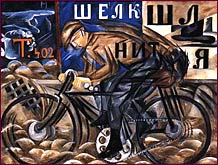 From
the end of the nineteenth century until about 1910, the modern
art movement remained most interested in traditional aspects
of Russian life - religion and village life were as influential
as the life of the great cities. As the forces of social reform
became more closely linked to the rising population of industrial
workers, Russia's avant-garde artists turned increasingly to
the factory and the frenetic pace of urban life for inspiration.
Brilliant colours, simplified and sharply angular forms, and
an emphasis on the liberatory energy of the modern world became
the basis for new and increasingly abstract compositions. Cubo-Futurism,
Rayonnism and Suprematism were the most important of the styles
and schools that emerged during this time. Among their most
prominent artists were Kasimir Malevich, Vasily Kandinsky, Vladimir
Tatlin, Mikhail Larionov, and Anna Goncharova. From
the end of the nineteenth century until about 1910, the modern
art movement remained most interested in traditional aspects
of Russian life - religion and village life were as influential
as the life of the great cities. As the forces of social reform
became more closely linked to the rising population of industrial
workers, Russia's avant-garde artists turned increasingly to
the factory and the frenetic pace of urban life for inspiration.
Brilliant colours, simplified and sharply angular forms, and
an emphasis on the liberatory energy of the modern world became
the basis for new and increasingly abstract compositions. Cubo-Futurism,
Rayonnism and Suprematism were the most important of the styles
and schools that emerged during this time. Among their most
prominent artists were Kasimir Malevich, Vasily Kandinsky, Vladimir
Tatlin, Mikhail Larionov, and Anna Goncharova.
The first few years of Soviet rule were marked by an extraordinary
outburst of social and cultural change.
|
 After
the 1917 Revolution, the Russian Avant-Garde leapt into the
service of the new Bolshevik regime. It seemed to promise just
the sort of break into a new world, and sweeping away of the
old, that they had been working for in art for years. They produced
political posters, organized street pageants and fairs, and,
most notably, carried out the design of the country's great
public spaces for anniversary celebrations of the Revolution.
Caught up in the new regime's emphasis on the importance of
industrial power, they began to bring to composition a sense
of the rationality and technological focus of industrial work
and design. Constructivism, as this style is known, continued
to evolve into the late 1920s, when the conservatism of the
Stalinist state renounced the Avant-Garde in favor of Socialist
Realism. After
the 1917 Revolution, the Russian Avant-Garde leapt into the
service of the new Bolshevik regime. It seemed to promise just
the sort of break into a new world, and sweeping away of the
old, that they had been working for in art for years. They produced
political posters, organized street pageants and fairs, and,
most notably, carried out the design of the country's great
public spaces for anniversary celebrations of the Revolution.
Caught up in the new regime's emphasis on the importance of
industrial power, they began to bring to composition a sense
of the rationality and technological focus of industrial work
and design. Constructivism, as this style is known, continued
to evolve into the late 1920s, when the conservatism of the
Stalinist state renounced the Avant-Garde in favor of Socialist
Realism.
The term, Socialist Realism, probably first occured in
print in an article in the Literary Gazette in May 1932. It
stated: "The masses demand of
an artist honesty, truthfulness, and a revolutionary, socialist
realism in the representation of the proletarian revolution."
In 1933, Maksim Gorki published an important article, "On
Socialist Realsim", talking of "a
new direction essential to us - socialist realism, which can
be created only from the data of socialist experience."
|
|
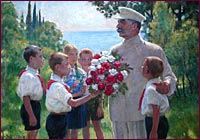 At
the break of the 1930s, the Soviet government has "terminated"
the Avant-garde, formally. The hundreds of paintings purchased
by various museums were hidden away in storage cellars or
sent out to small provincial museums, where most perished,
though some enthusiasts were able to save a few works. Drawings
were destroyed. And as to the artists themselves, they had
to either change their skin and proclaim the regime, or remove
themselves to teaching, organizing exhibitions and other such
peripheral jobs. And even that didn't always save their lives
and their secret "freedom" of expression. Many have
paid with their lives or their freedom for their will to create
differently, to innovate. Many lived in poverty, on the verge
of hunger, and the exceptions had to serve the lies and empty
slogans, and pay the toll. At
the break of the 1930s, the Soviet government has "terminated"
the Avant-garde, formally. The hundreds of paintings purchased
by various museums were hidden away in storage cellars or
sent out to small provincial museums, where most perished,
though some enthusiasts were able to save a few works. Drawings
were destroyed. And as to the artists themselves, they had
to either change their skin and proclaim the regime, or remove
themselves to teaching, organizing exhibitions and other such
peripheral jobs. And even that didn't always save their lives
and their secret "freedom" of expression. Many have
paid with their lives or their freedom for their will to create
differently, to innovate. Many lived in poverty, on the verge
of hunger, and the exceptions had to serve the lies and empty
slogans, and pay the toll.
Repudiated by the Stalinist government and neglected
in the west, the Russian Avant-Garde has only recently received
the attention it deserves. The Russian Museum in St. Petersburg
possesses the finest collection of its work.

|
|
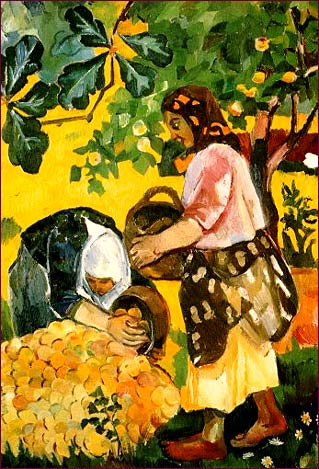
Natalia Goncharova, "Colelcting
Fruit", late 1900. |

|
|
Vasily Kandinsky
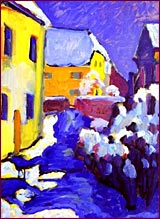 Vasily
Kandinsky (1866-1944) was born in Moscow into a merchant family.
While a student at Moscow University, in 1889, he got commissioned
by the "Society for Natural Science, Ethnography and
Anthropology" to go on a research expedition to Vologda. Vasily
Kandinsky (1866-1944) was born in Moscow into a merchant family.
While a student at Moscow University, in 1889, he got commissioned
by the "Society for Natural Science, Ethnography and
Anthropology" to go on a research expedition to Vologda.
The strong folk art of northern Russia made a lasting
impression on him, and the results of his trip made an impression
on the Society, which chose him their member.
|
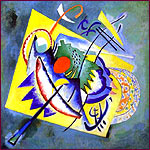 In
1892 Kandinsky got his Law degree. He became a lecturer at the
Moscow University. He pursued his academic career but at the
same time paid more and more attention to art. Thus in 1895
he took the post of art director of a publishing house in Moscow. In
1892 Kandinsky got his Law degree. He became a lecturer at the
Moscow University. He pursued his academic career but at the
same time paid more and more attention to art. Thus in 1895
he took the post of art director of a publishing house in Moscow.
|
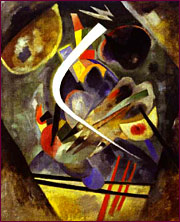 The
year of 1896 was a turning point in Kandinsky's life –
he went to Munich and began his art studies at Azbe's art school. The
year of 1896 was a turning point in Kandinsky's life –
he went to Munich and began his art studies at Azbe's art school.
Active creativity and organizational capabilities always
attracted different intellectuals who were in search of new
tendencies in art to Kandinsky.
Indeed, organization and teaching were to become the
main strands that would run alongside Kandinsky's artistic activities
throughout his life. He was never solely a painter, but a theoretician,
and organizer at the same time. Gifted author he expressed his
views on art and artistic activity in his numerous writings.
|
|

Vasily Kandinsky. In Blue. 1925.
Oil on canvas. Kunstsammlung Nordrhein-Westfalen, Germany.
But it was his landscapes, built on color dissonances,
which gradually took him to his most famous works, works of
abstraction. The play of colored spots and lines in his landscapes
gradually pushed out the images of the real world.
|
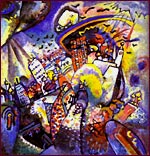 The
outbreak of the First World War took Kandinsky by surprise,
with his Russian passport he at once became a hostile alien
in Germany. He immediately fled to Switzerland and after three
months returned to Russia. The
outbreak of the First World War took Kandinsky by surprise,
with his Russian passport he at once became a hostile alien
in Germany. He immediately fled to Switzerland and after three
months returned to Russia.
Kandinsky settled in Moscow, feeling the necessity to
get new Moscow impressions. In February of 1917 he married for
the second time; his new wife Nina Andreevskaya was 27 years
younger.
In the 1920-30s Kandinsky's name became world famous.
He was proclaimed the theoretician and leading figure of abstract
painting. In addition to teaching courses, Kandinsky became
actively involved in delivering lectures; his exhibitions took
place almost yearly in Europe and America. Kandinsky died in
France in 1944 at the age of 78. |
|



